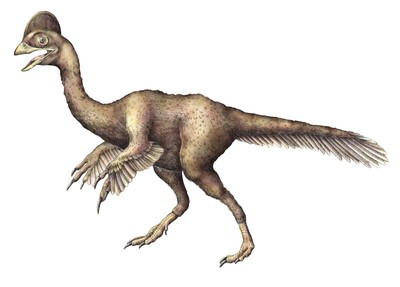A 10ft tall bird-like dinosaur dubbed the “chicken from hell” has been revealed by scientists.
Anzu Wyliei weighed 500lbs and lived alongside Tyrannosaurus rex 66 million years ago.
It sported a cockscomb crest on top of its head and also had rudimentary feathers, sharp claws and a toothless beak.
It is thought to have eaten both vegetation and small animals.
Dr Matt Lamanna, from the Carnegie Museum of Natural History in Pittsburgh, one of the US experts who described a newly constructed skeleton of the dinosaur, said: “We jokingly call this thing the ’chicken from hell,’ and I think that’s pretty appropriate.”
The bones were found at sites in North and South Dakota in a rock formation known as Hell Creek that has been a rich source of dinosaur fossils, including those of the iconic T. rex and Triceratops.
Although the “new” dinosaur’s remains were discovered years ago it took time for scientists to study and fully describe them.
Their findings appear in the online journal Public Library of Science ONE.
Co-author Dr Emma Schachner, from the University of Utah, said: “It was a giant raptor, but with a chicken-like head and presumably feathers.
“The animal stood about 10 feet tall, so it would be scary as well as absurd to encounter.”
She added: “I am really excited about this discovery because Anzu is the largest oviraptorosaur found in North America.
“Oviraptorosaurs are a group of dinosaurs that are closely related to birds and often have strange, cassowary-like crests on their heads.”
The cassowary is a flightless bird from New Guinea and Australia related to emus and ostriches.
A variety of bones from three of the creatures were pieced together to make up almost a full skeleton.
Two of the specimens showed signs of injury, either as a result of accidents or violent encounters with other dinosaurs.
“One appears to have a broken and healed rib, and the other has evidence of some sort of trauma to a toe,” Dr Schachner said.
The Hell Creek formation consists of clay, mudstone and sandstone deposited on ancient flood plains where giant dinosaurs roamed towards the end of their reign, between 66 and 68 million years ago.
Co-author Dr Hans-Dieter Sues, from the Smithsonian National Museum of Natural History in Washington D.C., said: “For almost a hundred years the presence of oviraptosaurs in North America was only known from a few bits of skeleton, and the details of their appearance and biology remained a mystery.
“With the discovery of A. wyliei, we finally have the fossil evidence to show what this species looked like and how it is related to other dinosaurs.”
Agencies/Canadajournal

 Canada Journal – News of the World Articles and videos to bring you the biggest Canadian news stories from across the country every day
Canada Journal – News of the World Articles and videos to bring you the biggest Canadian news stories from across the country every day

